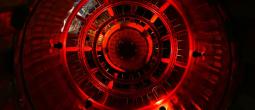

Propulsion Systems

The vessel is propelled through space by the main Magnetoplasma Impulse Engines (MIEs) at speeds of up to 20% of light, which is suitable for navigating within star systems.
Interstellar travel is achieved using an alien-sourced FTL drive, which manipulates space around the vessel to reduce the time needed to traverse between two distant points in the galaxy.
Other propulsion systems include the Reaction Control Systems (RCS) used on the vessel for docking, stationkeeping and orbital positioning adjustments, and antigravity drives used on small planetary shuttles.
Magnetoplasma Impulse Engines (MIE)
Main propulsion is provided by Magnetoplasma Impulse Engines (MIE's) which fuse existing terrestrial magentoplasma technology with alien-derived magneto-acceleration processes (known as impulse technology).
The first stage emits plasma created from ionising hydrogen, a technology that is well understood but based on current technology does not produce anywhere near the velocities required for deep space exploration.
The second stage accelerates the plasma using a complex series of powerful magnetic fields generated using alien-derived field generation technology. This massively increases the thrust produced by the engines, allowing velocities of up to 20% of light speed - high enough that relativistic effects become noticeable.
These velocities are suitable for intra-system maneuvering and to attain the relative velocities required for FTL travel.
FTL Drive
The FTL (Faster Than Light) drive generates the spatial manipulation fields that allow the vessel to reach relative velocities that are significantly faster than the speed of light.
The vessel itself does not reach absolute speeds any faster than those achieved by the main engines - the appearance of FTL speeds is achieved due to space-time manipulation.
The vessel must reach minimum absolute speeds of approximately 10% the speed of light (30,000km/s) before the spatial manipulation fields become effective.
Reaction Control System
The Reaction Control System (RCS) utilises a number of chemical rocket engines to allow minor adjustments to the vessel's attitude and position for close-range and orbital adjustment maneuvers.







